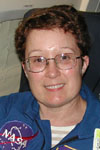
Leonid MAC top page
Next story

|
Whiteoaks.com home page Leonid MAC top page Next story |
|
A 400 mile late-evening drive took us from metropolitan San Francisco through the radiation or Tule fog of the California Central Valley to the dry lakebeds of the Mojave Desert, 100 miles north of Los Angeles. The dry lakebeds make a perfect place for a flight test facility. One of them, the Rosamond lakebed, has a curvature of less than 18 inches over a distance of 30,000 feet. Edwards Air Force Base was chosen as the site to flight test the nation's first jet aircraft, the Bell XP-59A Airacomet in the early 1940's. With a feeling of excitement, pride, and awe, Mojo and I joined our research team on a mission to study the debris of another comet — comet P/Tempel-Tuttle. The 2002 Leonid Multi-instrument Aircraft Campaign had officially begun. Our first duties were down-to-earth: badging, security, briefings, signing releases, and affixing our mission patches to our blue Nomex flight suits. The first mission briefing preceeded our 5:30 p.m. test flight. We strolled to the DC-8 Airborne Laboratory, while the near-full moon rose above the huge hangar adjacent to the flight line. We strapped on our seat belts, adjusted our headsets and took off. Our IMCU flux measurement team set up our meteor counting stations while the aircraft flew an "L" shaped flight path over Shafter, Panoche and Bishop on the eastern side of the Sierra Nevada range. Each of the 12 scientific teams set up and powered up their equipment. Nearly all the windows had frosted over, and nearly every instrument had one problem or another. I saw one meteor that night — a slow bright Taurid, though my i-goggles. Two hours later we were back at Edwards. Every one had a big to-do list for the next day. Next: Day 2 November 15 — a day of equipment troubleshooting, repair and an evening flight to Offut AFB, near Omaha, Nebraska. Day 3/4 November 16/17 — A plane to Spain! |